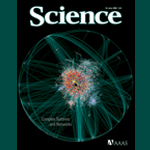UCI profs weigh in on growth of network analysis in special edition of Science

UCI profs weigh in on growth of network analysis in special edition of Science
- September 29, 2009
- Papers appear in July 24 issue
-----
 In a special network analysis-focused issue of Science magazine, papers by UCI School of Social Sciences professors Carter Butts, sociologist,
and Douglas White, anthropologist, highlight implications, applications and potential
growth areas of this rapidly expanding field.
In a special network analysis-focused issue of Science magazine, papers by UCI School of Social Sciences professors Carter Butts, sociologist,
and Douglas White, anthropologist, highlight implications, applications and potential
growth areas of this rapidly expanding field.
Used as a tool for explaining issues that range from the spread of HIV to the collapse
of the U.S. economy, Butts stresses the need for researchers and policy-makers alike
to regard network analysis as an evolving science. He uses as an example the spread
of HIV, where early applications of network models led some researchers to believe
that epidemic potential was driven by the presence of small numbers of individuals
with very large numbers of sexual partners. The data suggested that health policy
and intervention efforts should be focused primarily on these "hubs," rather than
the general public. Recent advances in network analysis, however, have allowed researchers
to take more factors into account when determining those most at risk for passing
on the disease. Their findings indicate that type of partner, duration of relationships,
and relationship concurrency may play a bigger role in passing the disease than simply
the raw number of sexual partners. "As we learn more about networks in a wider range
of contexts, we are discovering sometimes surprising things about what does and does
not matter for understanding social systems," says Butts.
White similarly highlights the need to reexamine and expand current models for understanding
the intricate networks in which economic systems operate. Using micro and macro approaches
- models which White notes are not ordinarily combined in the study of economic networks
- he and co-authors point out necessary factors in the challenge of predicting economic
stabilities and instabilities and in proposing economic policies. "With computational
models, large-scale network data can be processed and can reflect complex agent interactions,"
says White. Their findings emphasize that in order to understand the complexities
of economic systems and avoid potential breakdowns, a more system-oriented view -
one that takes into account the many dynamic factors affecting economic networks
- is needed.
Both papers appear in the July 24 special issue, available online at http://www.sciencemag.org/content/vol325/issue5939/index.dtl
-----
Would you like to get more involved with the social sciences? Email us at communications@socsci.uci.edu to connect.
Share on:
Related News Items
- Careet RightNotes from a future professor
- Careet RightCan Opportunity Zones ever meet their poverty-fighting promise?
- Careet RightFei Yuan named one of ten global China Times Young Scholar Fellows
- Careet Right'Wired for Words: The Neural Architecture of Language,' an excerpt
- Careet RightEveryone's looking for a partner who has these 3 traits, according to research


